When stories drop little hints before something big happens, it’s called foreshadowing.
It’s a little technique used to tell the reader that something relevant is going to happen later on.
A great example is the manga One Piece, where fans have touted its use of foreshadowing as one of the series’ strongest storytelling tools.
That subtle clue dropped hundreds of chapters earlier? It wasn’t random. It was creator Oda using literary devices with purpose.
Foreshadowing is just one of many literary devices. Writers have been using these tools for centuries to make their writing more impactful. Shakespeare used them. So did Maya Angelou.
Even your favorite influencer probably uses them without realizing it. Literary devices are fantastic techniques that make language more interesting, more memorable, and much more powerful.
Ready to decode the writing tricks that have been hiding in plain sight?
Let’s break down everything you need to know about literary devices, from the basics to the ones that’ll make your teacher think you’re some kind of literary genius.
What Are Literary Devices?
Literary devices are the special effects of writing.
Just like movies use CGI to create incredible visuals, writers use literary devices to create incredible experiences with words. They’re tools that authors use to convey meaning, create mood, and make their writing more engaging.
But here’s what’s cool about literary devices: they’re not just for fancy literature. You’ll find them in song lyrics, social media posts, advertising slogans, and even everyday conversation.
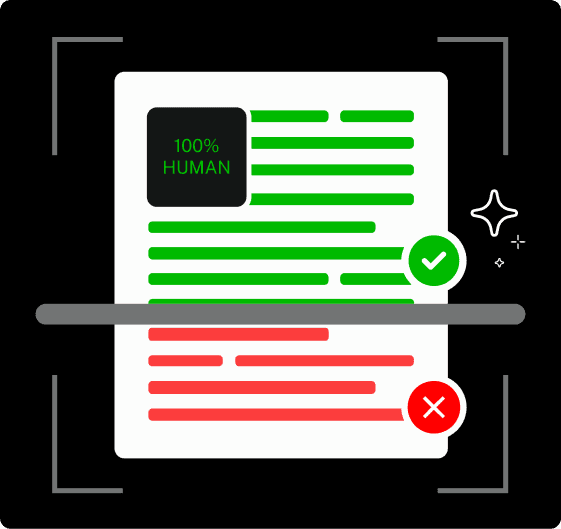
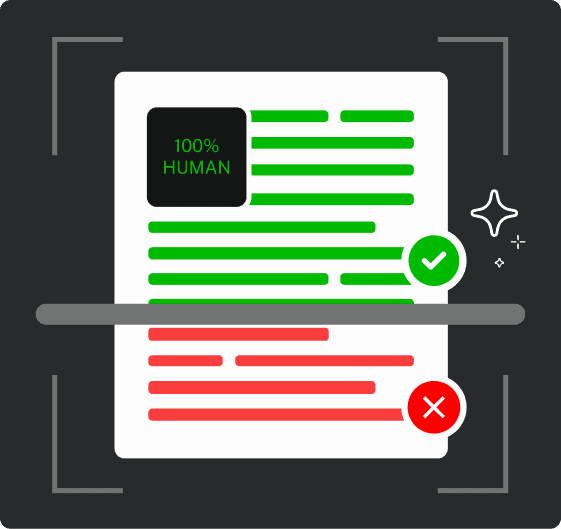
Never Worry About AI Detecting Your Texts Again. Undetectable AI Can Help You:
- Make your AI assisted writing appear human-like.
- Bypass all major AI detection tools with just one click.
- Use AI safely and confidently in school and work.
When someone says, “I’m so hungry I could eat a horse,” that’s hyperbole. When a brand calls their product “the Rolls-Royce of smartphones,” that’s a metaphor.
Literary devices work by playing with language in unexpected ways. They might repeat sounds, create comparisons, or structure sentences in patterns that stick in your brain.
Some make you feel emotions more deeply. Others help you visualize scenes more clearly. The best ones do both.
The beauty of literary devices is that they work on multiple levels. A metaphor might create a vivid image while also revealing something deeper about a character’s psychology.
Alliteration might make a line sound pleasing while also emphasizing key words. It’s like getting multiple benefits from one technique.
When you know why certain phrases give you chills or why some passages stick with you long after you’ve finished reading, you’re unlocking the secret mechanics of great writing.
The Most Common Literary Devices (with Examples)

Let’s start with the heavy-hitters.
The literary devices you’ve probably seen a hundred times but maybe didn’t know had names.
These are the tools writers use constantly to shape meaning, add flair, and keep readers hooked.
From foreshadowing in your favorite short story to metaphors in music lyrics, here’s how the most common devices actually work, plus examples you’ll recognize instantly.
Sound-Based Devices
These devices play with how words sound when you read them aloud or in your head.
They create rhythm, emphasis, and sometimes just pure aesthetic pleasure.
- Alliteration is probably the most recognizable sound device. It’s when words start with the same sound, like “Peter Piper picked a peck of pickled peppers.” You see this everywhere in brand names (Coca-Cola, PayPal) and song titles. In literature, it can create emphasis or make phrases more memorable. Maya Angelou used it beautifully in “I Know Why the Caged Bird Sings.”
- Assonance focuses on repeating vowel sounds within words. Edgar Allan Poe was obsessed with this technique. In “The Raven,” he writes, “Once upon a midnight dreary, while I pondered, weak and weary.” Notice how those long E sounds create a haunting, drawn-out feeling that matches the poem’s mood.
- Consonance repeats consonant sounds, but not necessarily at the beginning of words. It’s subtler than alliteration but just as effective. Think about the phrase “pitter patter” or how rappers use consonance to create internal rhymes that make their lyrics flow better.
- Onomatopoeia is when words actually sound like what they describe. “Buzz,” “crash,” “whisper,” “bang.” Comic books are full of these (POW! BAM!), but they’re also used in literature. They bring immediate sensory experience to your writing.
- Rhythm and meter control the beat of language. Even if you’re not writing poetry, your sentences have rhythm. Short, punchy sentences create urgency. Longer, flowing sentences create a more relaxed pace. Good writers pay attention to this musical quality of language.
Meaning-Based Devices
These devices create meaning through comparison, exaggeration, or saying one thing while meaning another.
They’re the heavy hitters of literary analysis.
- Metaphors say one thing IS another thing. “Life is a journey,” or “Time is money.” Metaphors don’t use “like” or “as.” They create direct, non-literal, often surprising connections between different concepts. Shakespeare’s “All the world’s a stage” is probably the most famous metaphor in English literature.
- Similes make comparisons using “like” or “as.” “She fights like a tiger,” or “He’s as stubborn as a mule.” Similes are often more accessible than metaphors because they clearly signal that a comparison is being made. They’re great for creating vivid imagery quickly.
- Personification gives human characteristics to non-human things. “The wind whispered through the trees” or “The sun smiled down on us.” This device helps readers connect emotionally with abstract concepts or natural phenomena. It’s everywhere in poetry and children’s literature.
- Hyperbole is deliberate exaggeration for effect, such as “I’ve told you a million times” or “This bag weighs a ton.” We use hyperbole constantly in casual conversation. In literature, it can create humor, emphasize emotions, or show a character’s dramatic personality.
- Symbolism uses objects, colors, or actions to represent deeper meanings. A dove symbolizes peace, a red rose symbolizes love, and a journey often symbolizes personal growth. The key is that symbols work on both literal and figurative levels simultaneously.
- Irony comes in three main types. Verbal irony is saying one thing but meaning another (sarcasm is a type of verbal irony). Situational irony is when the outcome is opposite to what’s expected. Dramatic irony is when readers know something characters don’t. All three create layers of meaning that reward careful readers.
- Allusion slips in a reference to something outside the text—another book, a myth, a pop culture moment, or even a historical event. “Don’t act like a Romeo,” or “This test is my Mount Everest.” The meaning becomes more resonant if you recognize the reference, but even if you don’t, the context usually gives it away. Allusions add depth without detouring into explanation. It trusts the reader to make the connection.
Structure-Based Devices
These devices organize and arrange language to create a specific impact. Think of them like the architecture of writing.
- Repetition repeats words, phrases, or ideas for emphasis. Martin Luther King Jr.’s “I Have a Dream” speech uses repetition masterfully. The repeated phrase creates rhythm and drives home the central message. In writing, repetition can build intensity or highlight important themes.
- Parallelism structures similar ideas in similar ways. “I came, I saw, I conquered” is an example of parallel structure. It creates balance and makes ideas more memorable. You’ll find parallelism in everything from political speeches to song lyrics because it has such a psychological impact.
- Juxtaposition puts contrasting elements side by side. Charles Dickens opens “A Tale of Two Cities” with a famous juxtaposition: “It was the best of times, it was the worst of times.” This technique highlights differences, creating tension and emphasizing themes.
- Foreshadowing hints at future events. It creates suspense and makes readers feel clever when they pick up on clues. Horror movies use obvious foreshadowing, but literary foreshadowing is usually subtler. It might be a casual comment that becomes significant later or symbolic imagery that predicts the ending.
- Flashbacks interrupt the chronological narrative to showcase past events. They provide background information and can create dramatic irony. TV shows and movies use flashbacks constantly, but in literature, they need to be integrated more smoothly into the narrative flow.
- Chiasmus reverses the order of words or concepts in successive phrases, like “Ask not what your country can do for you; ask what you can do for your country.” It creates a satisfying sense of balance and makes statements more memorable.
Literary Devices in Poetry vs. Prose
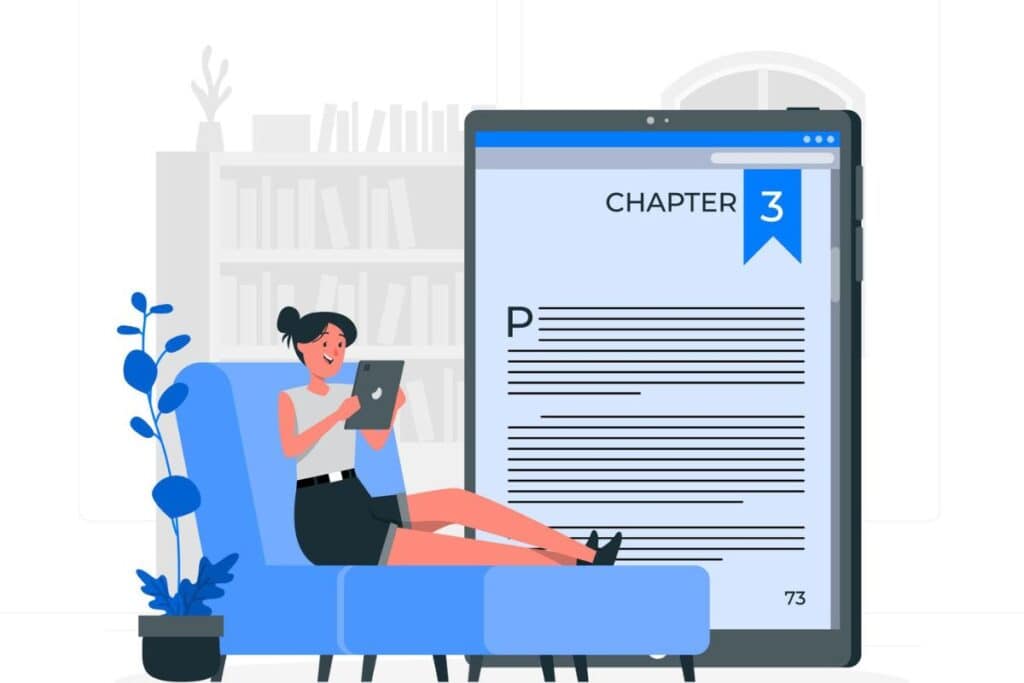
Poetry and prose use literary devices differently, like how a chef and a baker might both use butter but in different ways.
Poetry condenses literary devices. Every word matters more because there are fewer of them, where a single metaphor might carry an entire poem.
Sound devices become crucial because poetry is meant to be heard, even when read silently.
The rhythm of each line contributes to the overall meaning.
Take Emily Dickinson’s poetry. She packs multiple devices into just a few lines. Slant rhyme, unexpected metaphors, and capitalized words all work together to create her distinctive voice.
In poetry, literary devices often layer on top of each other, creating complex effects from simple language.
If you want to try using these devices in your own writing, you can explore our Undetectable AI’s Poem Generator.
It lets you experiment with imagery, rhythm, metaphors, and sound patterns by shaping your ideas into poem form.
This makes it easier to see how different devices change the tone or impact of a piece, especially when you are still learning how each technique works.
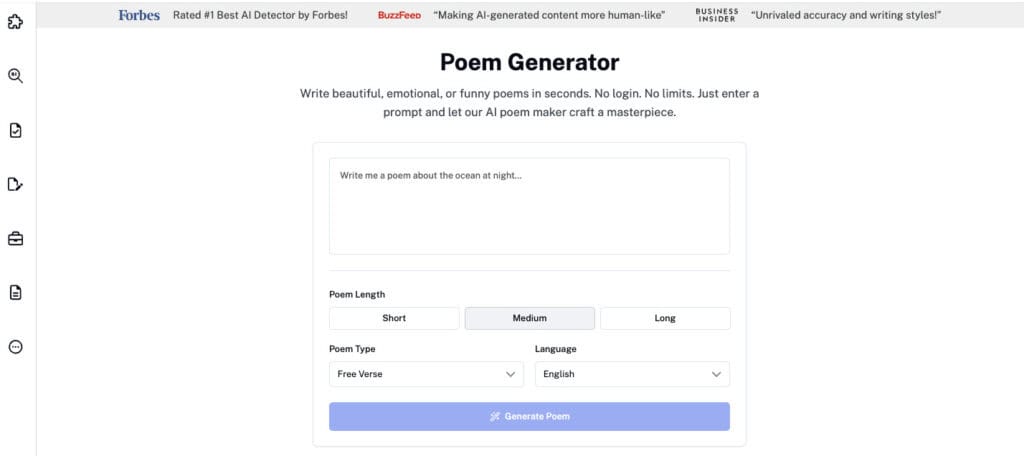
Prose has more room to breathe. Novels can develop metaphors across hundreds of pages. A symbol might appear early in a story and gain meaning as the plot progresses.
Prose writers can be subtler with their devices because they have space to build effect gradually.
Consider how J.K. Rowling uses literary devices in the Harry Potter series. The scar on Harry’s forehead starts as a simple plot device but becomes a complex symbol of connection, sacrifice, and identity.
That kind of development needs the extended space that prose provides.
Genre also matters. Literary fiction tends to use devices more subtly and ambiguously. Genre fiction (mystery, sci-fi, romance) often uses devices more directly to create specific effects.
Young adult literature might use devices that are more immediately accessible to its target audience.
The key difference is density versus development.
When writing poetry, your goal is to intensify through concentrated use of devices.
Prose achieves depth through extended exploration of devices. Both approaches can be equally powerful, but they require different reading strategies.
Literary Devices and Their Meanings: A Reference Table
| Device | Definition | Example | Effect |
| Alliteration | Repetition of initial consonant sounds | “Sally sells seashells” | Creates rhythm, emphasis |
| Metaphor | Direct comparison without “like” or “as” | “Life is a rollercoaster” | Creates vivid imagery, deeper meaning |
| Simile | Comparison using “like” or “as” | “Brave as a lion” | Creates clear, accessible imagery |
| Personification | Giving human traits to non-human things | “The wind danced” | Makes abstract concepts relatable |
| Hyperbole | Deliberate exaggeration | “I’m dying of laughter” | Adds humor, emphasizes emotion |
| Irony | Contrast between expectation and reality | Saying “Great weather!” during a storm | Creates humor, highlights contradictions |
| Symbolism | Object representing deeper meaning | Dove = peace | Adds layers of meaning |
| Foreshadowing | Hints about future events | Dark clouds before tragedy | Builds suspense, creates unity |
| Flashback | Scene from the past | Character remembering childhood | Provides background, context |
| Repetition | Repeating words or phrases | “Never, never, never give up” | Emphasizes importance, creates rhythm |
| Onomatopoeia | Words that sound like their meaning | “Buzz,” “crash,” “whisper” | Engages senses, creates immediacy |
| Juxtaposition | Placing contrasts side by side | “Rich and poor lived on the same street” | Highlights differences, creates tension |
How to Use Literary Devices in School Projects
Literary devices aren’t just things you identify in other people’s writing. Understanding how to use them in your own work will make your essays more engaging and your creative writing more sophisticated.
Here’s how to level up your school projects.
- Start small with the devices you already know. Don’t try to cram every literary device into one essay. Pick two or three that serve your purpose and use them well. A strong metaphor that runs through your entire piece is better than five weak examples of different devices.
- Match the device to your goal. Writing a persuasive essay? Try repetition and rhetorical questions. Creating a narrative? Focus on imagery and symbolism. Analyzing literature? Look for patterns in how the author uses specific devices. The best literary devices feel natural, not forced.
- Practice with low-stakes writing first. Try using literary devices in journal entries, social media posts, or casual creative writing before bringing them into formal assignments. This helps you develop an intuitive sense of what works and what doesn’t.
- Read your work aloud. Sound devices only work if they actually sound good. Rhythm and flow matter even in prose. If something sounds awkward when you read it aloud, revise it. Your ear is often a better editor than your eyes.
- Don’t explain your devices unless asked. Use literary devices well, and they should enhance meaning without drawing attention to themselves. If you find yourself needing to point out your clever metaphor, it might not be as effective as you think.

If you need help understanding how specific literary devices work in the texts you’re analysing, Undetectable AI’s Ask AI can help explain complex literary concepts and even assist with citation formatting for your research papers. It’s like having a writing assistant available 24/7.
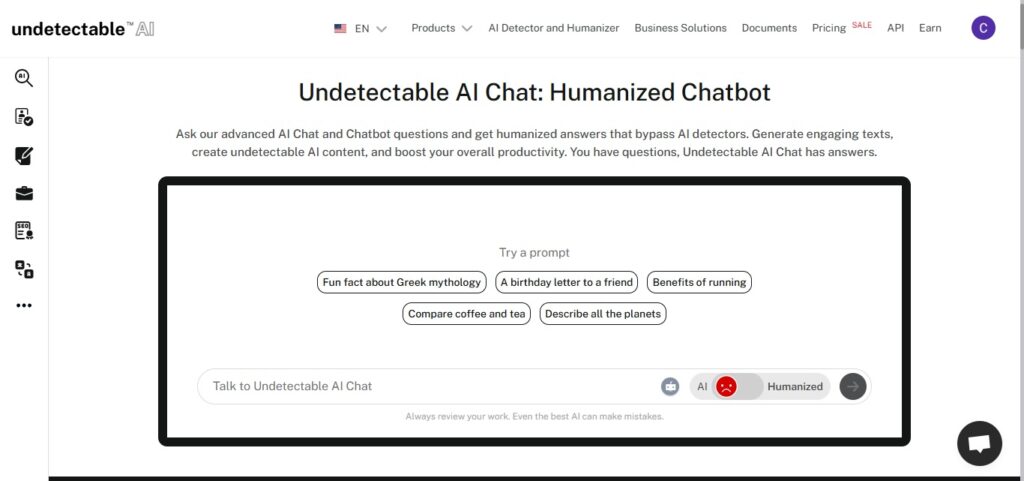
Want to test your understanding of different literary devices? Undetectable AI’s AI Chat can quiz you on device identification, help you brainstorm creative uses for each technique, or even help you practice incorporating devices into your own writing.
It’s perfect for preparing for tests or just deepening your understanding of how these tools work.
Give your words a makeover—our AI Detector and Humanizer are just below!
Depth with a Purpose
Literary devices are the building blocks of effective communication, and once you start recognizing them, you’ll see them everywhere.
From the alliteration in your favorite song lyrics to the metaphors in your Instagram captions, these techniques shape how we experience language every single day.
The best part about understanding literary devices is that it makes you both a better reader and a better writer.
You’ll start noticing why certain passages give you chills or why some arguments feel more convincing than others. You’ll develop an intuitive sense of what makes language work.
Don’t worry about memorizing every single device or spotting them all in every text you read. Focus on understanding how these techniques create meaning and emotion.
Pay attention to the ones that resonate with you personally. Everyone responds differently to different devices, and that’s perfectly normal.
When you’re ready to level up your writing or break things down with confidence, Undetectable AI can help you stay sharp and sound human while you’re at it.
